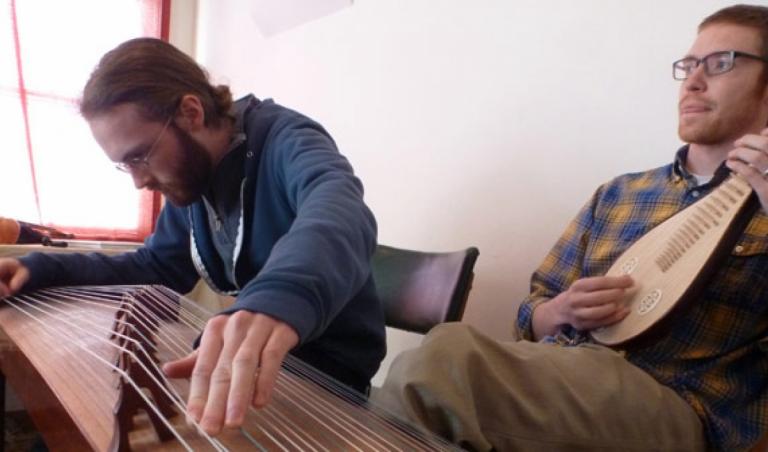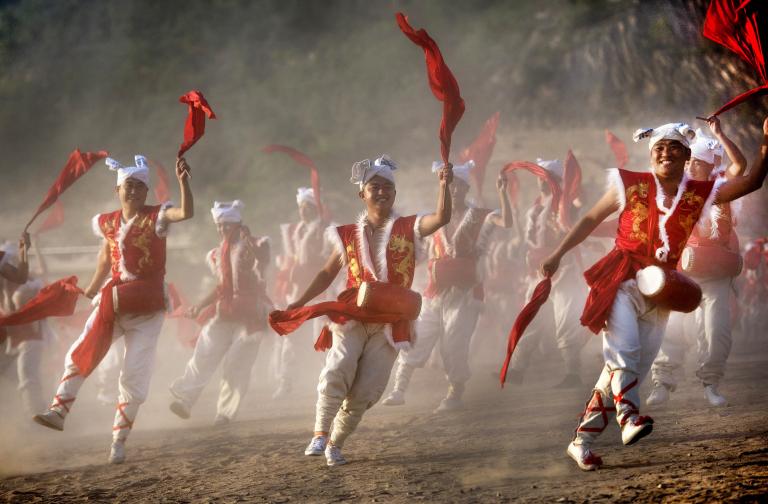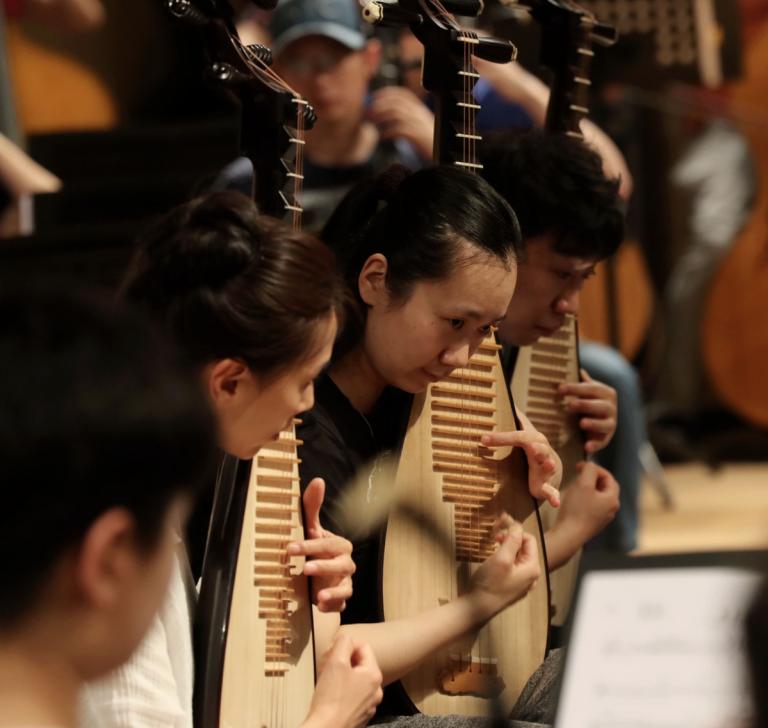Lingering Ethnic Sound
6 min readChina is a country with 56 ethnic groups, and each ethnic group has its unique music. From the region south of the lower reaches of the Yangtze River to the region north of the Great Wall, from the East China Sea to the Western Regions, there are numerous ethnic groups good at both singing and dancing. Music has become a symbol of ethnic culture.

Uygurs are an ethnic group gathering at the foot of the Tianshan Mountain goodat both singing and dancing, and muqams are the crystallization of their music.
Muqams originated from the culture of aboriginal ethnic groups in the Western Regions, and were deeply influenced by the Islamic culture. They are a form of Islamic ethnic groups’ music. When Uygurs’ ancestors engaged in fishing, hunting and animal husbandry, impromptu songs expressing emotions emerged in the wilderness, among the mountains and on the grassland. Later, after constant integration, change and development,”boyawan”suites were formed as the embryonic form of muqams. The official inclusion of muqams into the Chinese nation’s cultural treasure was closely related to a great Uygur woman named Amannisa (1533-1567). She loved music and poetry. In 1547, after becoming the queen of the Yerqiang Kingdom, she gathered a lot of musicians and muqam singers, sorted out muqams on a large scale, made them systematic and standardized, removed abstruse foreign words, ancient Uygur words and old court poems in original muqam lyrics, and created brand new muqams with a complete structure and rigorous system easy to read and comprehend.
Today, muqams are distributed in a lot of regions. Arabia, Persia, Turkey, India and Central Asia all have muqams, but in terms of their types, Xinjiang’s muqams are most diversified in the world at present. There are a series of suites with regional characteristics such as Hami Muqam, Hotan Muqam, Dolan Muqam and Ili Muqam. In 2005,”the Art of Uygur Muqam of Xinjiang, China”was included into the list of intangible cultural heritage sites in the world.
Mongolians, an ancient ethnic group, created their splendid nomadic culture in the long history, and Mongolian long-tune folk songs are a phenomenon in their culture.
Where there is grassland, there are herdsmen; where there are herdsmen, there are long tunes. Long tunes are songs sung by horse riders around the vast grassland.

Mongolian long-tune folk songs are a unique form of singing with prominent regional and cultural features, describing understanding and comprehension of nature and human culture in a language particular to people on the grassland, and closely related to Mongolian literature. Mongolian long tunes are an artistic form representing the highest accomplishments in Mongolian singing. In thousands of years, Mongolians passed them down through explanation by words and communication by heart from generation to generation, making long tunesincreasingly mature and reverberate above the vast grassland for long.
Mongolian long tunes have structures and elements different from the singing art of any other ethnic group in the world. The beautiful melodies, complex thrills and internal rhythms perceivable only by intuition are especially worthy of praise. Long tune singers often shift from the low pitch area to the high pitch area and shift to the low pitch area again in a complete period. Sometimes this course repeats several times in a long tune. The course of singing long tunes requires the singer to grasp them according to his accumulation of life experience and comprehension of life instead of expressing art according to fixed beats in ordinary songs. In other words, different people sing long tunes with different rhythms.
Most long tunes describe scenes such as blue sky, white clouds, rivers, lakes, fine horses, camels, cows, sheep and yurts and are sung with natural voice. They describe nature, praise life and vividly express Mongolians’ wisdom and deepest feelings. Long tunes are music in Mongolians’ blood, harmonious sound of man and nature, and direct heart-to-heart talks. Whenever and wherever melodious Mongolian long tunes are heard, people associate them with the vast grassland and experience the joy of spring, the passion of summer, the richness of autumn and the desolation of winter particular to the grassland. In 2005,”Mongolian long-tune folk songs”were included into the list of intangible cultural heritage sites in the world upon joint application by China and Mongolia.
Dong people mainly lived at the junction of Guizhou, Hunan and Guangxi. Dong people’s grand songs with a history of more than 2,500 years are a folk natural chorus form of multi-part singing performed without instrumental accompaniment or a conductor. In 1986, at the Golden Autumn Art Festival in Paris, France, the grand song sung by Dong people from Liping, Guizhou startled all present and was reputed by foreign music critics as “music glittering like clear spring water and melody flitting past old dreams”.
Dong people’s grand songs are unique in temperament structures, singing techniques and performance sites. They are a kind of choruses sung by one leading singer accompanied by multi-part singing of many people indifferent pitches very rare in Chinese and foreign folk music. Dong people’s grand songs not only are a form of music, but also play a very important role in the inheritance of Dong people’s ethnicculture and spirit. Dong people’s representative grand songs include Song of Cicadas, Song of Squirrels, Beautiful Mountains, etc.
As the Dong saying goes,”foods nourish the body and songs nourish the mind”.
They think “songs”and “foods”are equally important. In their opinion, songs are knowledge and culture, and people who can sing more songs are more knowledgeable and cultured. In the Dong area, singers are the most respected people. They loved songs, learned songs, sang songs, enjoyed songs and took pride in songs for generations. Songs are closely related to and inseparable from Dong people’s social life. Dong people’s grand songs have become their everlasting songs. Their contents
of singing and forms of expression are all closely associated with Dong people’s customs,personalities,psychologies and living environments.They are true records of Dong people’s history and direct manifestations of Dong people’s culture.In 2009,Dong people’s grand songs were included into the list of intangible cultural heritage sites in the world.
Actually,music plays an important role in the daily life of many minority ethnic groups in China. In some places inhabited by minority ethnic groups, you can find that people of both sexes and all ages love songs and sing joyfully in a loud voice impromptu in daily production and labor. On festive days such as the occasions of festivals, new house construction, wedding ceremonies and visits to relative and friends, singing is an indispensable entertainment activity. Large-scale singing fairs can even last several days. Young men and women often express love through songs, so love songs account for a very large proportion in minority ethnic groups’ folk songs.
These folk songs adopt the methods of description, metaphor and analogy like poems, and contain abundant imaginations, proper metaphors and vivid words. There are many lively works. The singing forms include solos, duets, singing in unison, singing in rounds and choruses.
According to incomplete statistics, the 55 Chinese minority ethnic groups have more than 500 musical instruments of different forms, including bowed instruments, wind instruments, plucked instruments and percussion instruments, and each musical instrument is very expressive. On the basis of these musical instruments with unique characteristics, different styles of tunes emerged,e.g. Tujia people’s “daliuzi”and Naxi people’s “baishaxiyue”. The “reed pipe music”and “bronze drum music”of Miao people, Zhuang people, Yi people, Dong people, Yao people and Lahu people are also very famous.









